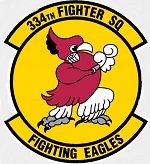Hobby Master HA8515 USAAF North American P-51B Mustang Fighter - Lieutenant Steve Pisanos, 334th Fighter Squadron "Fighting Eagles", 4th Fighter Group, Essex, England, May 1944 (1:48 Scale)
"Why should we have a navy at all? There are no enemies for it to fight except apparently the Army Air Force."
- Motto of the Tuskegee Airmen
 No other aircraft of WWII could fly as high, go as far, or fight as hard as the famed Mustang. Piloted by a record 281 Aces, this agile and ferocious dogfighter tallied more kills than any other Allied airplane. As the bombers of the Eighth Air Force fought their way deep into Hitler's Germany, it was the Mustang that cleared the skies of Luftwaffe fighters. The powerful Rolls-Royce Merlin engine gave the Mustang a speed of 445 mph. Re-styled with an aerodynamic bubble canopy for greater visibility, and outfitted with 6 fast-firing .50 caliber machine guns, the P-51 became the best fighter of the war.
No other aircraft of WWII could fly as high, go as far, or fight as hard as the famed Mustang. Piloted by a record 281 Aces, this agile and ferocious dogfighter tallied more kills than any other Allied airplane. As the bombers of the Eighth Air Force fought their way deep into Hitler's Germany, it was the Mustang that cleared the skies of Luftwaffe fighters. The powerful Rolls-Royce Merlin engine gave the Mustang a speed of 445 mph. Re-styled with an aerodynamic bubble canopy for greater visibility, and outfitted with 6 fast-firing .50 caliber machine guns, the P-51 became the best fighter of the war.
New P-51Bs (NA-102s) would continue with the same armament and ammunition load of the P-51A, while the bomb rack/external drop tank installation was adapted from the A-36 Apache; the racks were rated to carry up to 500 lb (230 kg) of ordnance and were also piped for drop tanks. The machine guns were aimed using the electrically illuminated N-3B reflector sight fitted with an A-1 head assembly which allowed it to be used as a gun or bomb sight through varying the angle of the reflector glass. Pilots were also given the option of having ring and bead sights mounted on the top engine cowling formers. This option was discontinued with the P-51D.
The first XP-51B flew on November 30th, 1942. Flight tests confirmed the potential of the new fighter, with the service ceiling being raised by 10,000 ft (3,000 m), with the top speed improving by 50 mph (43 kn; 80 km/h) at 30,000 ft (9,100 m). American production was started in early 1943 with the P-51B (NA-102) being manufactured at Inglewood, California, and the P-51C (NA-103) at a new plant in Dallas, Texas, which was in operation by summer 1943. The RAF named these models Mustang Mk III. In performance tests, the P-51B reached 441 mph (383 kn; 710 km/h) at 30,000 ft (9,100 m). In addition, the extended range made possible by the use of drop tanks enabled the Merlin-powered Mustang to be introduced as a bomber escort with a combat radius of 750 mi (1,210 km) using two 75 US gal (62 imp gal; 280 l) 2-piece, sheet-metal stamped construction drop tanks.
The range would be further increased with the introduction of an 85 US gal (71 imp gal; 320 l) self-sealing fuel tank aft of the pilot's seat, starting with P-51B-5-NA ("block 5"). When this tank was full, the center of gravity of the Mustang was moved dangerously close to the aft limit. As a result, maneuvers were restricted until the tank was down to about 25 US gal (21 imp gal; 95 l) and the external tanks had been dropped. Problems with high-speed "porpoising" of the P-51Bs and P-51Cs with the fuselage tanks would lead to the replacement of the fabric-covered elevators with metal-covered surfaces and a reduction of the tailplane incidence. With the fuselage and wing tanks, plus two 75 US gal (62 imp gal; 280 l) drop tanks, the combat radius was 880 mi (1,420 km).
Pictured here is a 1:48 scale replica of a North American Mustang P-51B fighter that was flown by Lieutenant Steve Pisanos, who was attached to the 334th Fighter Squadron "Fighting Eagles", 4th Fighter Group, then deployed to Essex, England, during May 1944. Sold Out!
Dimensions:
Wingspan: 8-1/2-inches
Length: 7-1/2-inches
Release Date: August 2023
 Historical Account: "The Flying Greek" - Steven Nicholas Pisanos (born Spiros Pisanos (November 10th, 1919 - June 6th, 2016) was a Greek-American aviator and flying ace who served as a fighter pilot with the British Royal Air Force (RAF) and later the United States Army Air Forces in World War II. He was credited with shooting down 10 enemy aircraft while flying with the American 4th Fighter Group. Post-war, he achieved the rank of colonel in the United States Air Force, flew in the Vietnam War and, by the end of his career in 1974, had received 33 decorations and distinctions. His autobiography, The Flying Greek, was published in April 2008.
Historical Account: "The Flying Greek" - Steven Nicholas Pisanos (born Spiros Pisanos (November 10th, 1919 - June 6th, 2016) was a Greek-American aviator and flying ace who served as a fighter pilot with the British Royal Air Force (RAF) and later the United States Army Air Forces in World War II. He was credited with shooting down 10 enemy aircraft while flying with the American 4th Fighter Group. Post-war, he achieved the rank of colonel in the United States Air Force, flew in the Vietnam War and, by the end of his career in 1974, had received 33 decorations and distinctions. His autobiography, The Flying Greek, was published in April 2008.


